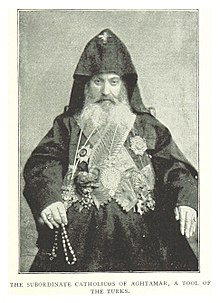Catholic of Aghtamar of the Armenian Apostolic Church

The Armenian Catholic of Aghtamar (Ałt'amar) was a temporarily independent part of the Armenian Apostolic Church .
Beginnings
Aghtamar served on 10/11. Century as the residence of the Catholicos of the Armenian Apostolic Church. A separate Catholic was established in Aghtamar in 1113 as a reaction to the controversial election of the incumbent Catholic Gregor III in Cilician Lesser Armenia . (1113-1166). The Catholicos of Aghtamar initially claimed general and supreme jurisdiction over Armenian Christianity. In 1114 it was therefore excommunicated by the traditional Armenian Catholics transferred to Cilicia .
The residence of the Catholicos was the important monastery and church complex on the island of Aghtamar . Because of its greater proximity to the Armenian settlement areas in Greater Armenia compared to its Cilician rival , the Catholic of Aghtamar temporarily exercised considerable influence there, also judicially. The excommunication of Aghtamar was lifted by the newly founded Catholic of Echmiadzin near Vagharschapat in 1441 . But failed under the Katholikoi Zacharias III. Aghtamar (1434–1464) and his successor Stephanos V (1465–1487) attempted to unite the Catholics of Etschmiadzin with those of Aghtamar under their leadership.
Jurisdiction
In the later centuries the Catholic of Aghtamar had jurisdiction only in Vaspurakan , in the area around Lake Van , with the city of Van even being eliminated in the 19th century. Like the Catholic of Cilicia in Sis (today in Antelias ), that of Aghtamar was not considered schismatic in modern times , but as a regional Catholic (similar to the Armenian patriarchates of Constantinople and Jerusalem). The Catholicos of Aghtamar had the privilege of ordaining bishops and consecrating Myron . In the 16./17. In the 19th century, the former center of Eastern Armenian culture of the late Middle Ages lost its charisma and was finally replaced by the Varag Monastery with its dynamic ruler Chrimian Hayrig in the 19th century at the latest .
In 1910 the Catholic of Aghtamar had two dioceses with 95,000 souls: the diocese of Aghtamar with 203 churches and 70,000 believers and the diocese of Chisan with 69 churches and 25,000 believers.
Loss of power and end
The Artsruni monopolized the seat of the Catholicos for a long time within their dynasty, usually in the sequence uncle → nephew. In modern times, autocephaly was definitely lost. In the 17th / 18th In the 17th century, the Catholikoi of Aghtamar were consecrated by the Catholicos of Echmiadzin. In the 19th century, the Armenian Patriarchate of Constantinople claimed jurisdiction over Aghtamar and tried several times to repeal the Catholic there. In order to facilitate contacts between foreigners and the remote Catholikos, Catholicos Khatchatur III. a mainland residence in Akhavank Monastery (now Gevaş ) on the south bank of Lake Van . The monastic brotherhood of Aghthamar used Akhavank as a summer monastery.
The cathedra of the Catholicos of Aghtamar was regularly manned until 1895. After that there was still a locum tenens , first the Wardapet Arsan Markarian († 1904). By law of July 28th / 10th August 1916 of the Ottoman Ministry of Justice and Culture, the two Catholics of Aghtamar and Cilicia (Sis) were merged with the two Armenian Patriarchates of Constantinople and Jerusalem and a "Catholicos Patriarch" of all Armenians of the Ottoman Empire, who was only temporarily in office with Sahag II Subordinate to Jerusalem. In contrast to Cilicia, Constantinople and Jerusalem, the Catholic of Aghtamar did not revive afterwards.
With the genocide of the Armenians in the Ottoman Empire , the bishopric of Aghtamar went under, like the other Armenian dioceses in Asia Minor.
See also
literature
- Frédéric Macler: Le Liber pontificalis des Catholicos d'Agthamar . In: Journal Asiatique , Vol. 202 (1923), pp. 37-69, ISSN 0021-762X
- Robert H. Hewsen: Artsrunid House of Sefedinian. Survival of a Princely Dynasty in Ecclesiastical Guise . In: Journal of the Society for Armenian Studies , Vol. 1 (1984), pp. 123-137, ISSN 0747-9301
- Krikor Chahinian: L'istituzione catholicosale nella Chiesa armena dalle origini fino al 1441 (Canon 14). Rome: PIO 2009, pp. 166-173. ISBN 978-8-87210-362-3 .
Web link
Individual evidence
- ↑ The nobly designed Myron kettle from Aghtamar, today in the Etchmiadzin Museum. dated from 1883. Paul Rohrbach also proves that Aghtamar claimed the right to consecrate the Myron up to the end: From the Caucasus to the Mediterranean. A wedding and study tour through Armenia . Teubner, Leipzig / Berlin 1903. p. 70.
- ^ A b Robert H. Hewsen: Armenia. A Historical Atlas , The University of Chicago Press, Chicago and London 2001, 208
- ↑ Archbishop Maghakia Ormanian : The Church of Armenia , V. and H. Der-Nersesian, Constantinople 1911 [Original title: Հայոց եկեղեցին եւ իր պատմութիւնը վարդապետութիւնը վարչութիւնը բարեկարգութիւնը արարողութիւնը գրականութիւնը ու ներկայ կացուիւնը:], page 263
- ↑ Historical photo of Akhavank Monastery, late 19th century.
- ↑ Patriarch Zaven Der Yeghiayan : My Patriarchal Memoirs , Mayreni Publishing, Barrington (RI) 2002 ISBN 1-931834-05-9 [the Armenian original published in Cairo in 1947], page 128.
